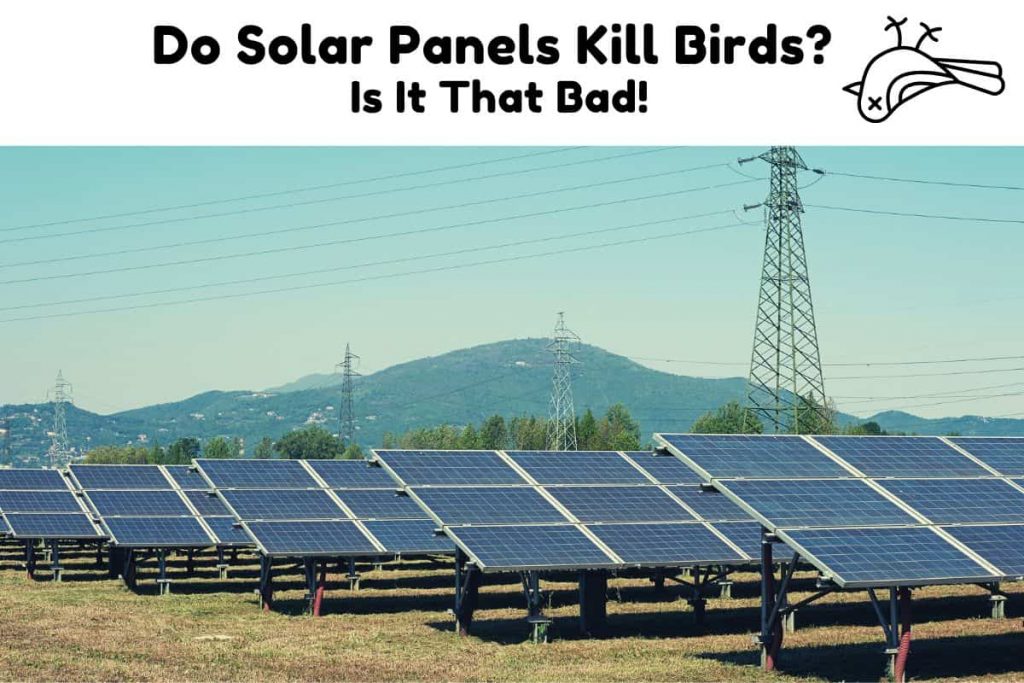Have you ever wondered what happens when a bird sits on a solar panel? If you have then this article is for you because we are going to answer that very question.
Residential solar installations do not kill birds but large solar farms do. One do not have to worry about the solar panels installed on home roof but there is considerable evidence suggesting that large-scale solar installations have a detrimental effect on birds.
As of the end of 2020, the U.S has enough solar installed to power over 16 million homes. A large part of this capacity is supplied by large solar farms. At four times the size of Central Park, Solar Star is America’s largest solar farm, producing 579MW.
You can be certain that investment in solar will keep growing. While solar has a net benefit on the environment, what effect does it have on wildlife? Should you be worried that your rooftop solar will diminish the local bird population?
On a side note! If you’re in need of a reliable and high-performance portable solar panel, We strongly recommend the Jackery SolarSaga 100W Portable Solar Panel (Amazon Link).
With a high conversion efficiency and foldable design, this solar panel is easy to transport and set up, making it perfect for outdoor activities like camping, hiking, and RV trips.

The US solar cell technology used in this panel ensures that you get the most efficient and reliable solar charging possible.
There is also a 60W option that is more affordable (Amazon Link)
If you are concerned about the net cost of solar panels then keep reading because these are the questions we are exploring in this article.

Do Solar Panels Harm Wildlife?
Residential solar panels like the ones people use in their individual homes do not harm wildlife. There is conclusive evidence to support that commercial solar energy farms and power plants on the other hand do harm wildlife. The biggest impact solar farms have is on bird populations.
In a bid to reduce its carbon emissions, America has set a target of 80% renewable energy by 2030. Solar is seen as being the key to reaching this target with over 4,600 square miles of land set aside for solar energy farms. (Source)
Commercial solar farms are large tracts of land covered in photovoltaic solar panels. They can be anything from 1 to 1000 acres in size producing hundreds of megawatts of power for the grid or a small local community. The largest solar farm in the world, the Engger Desert Solar Park in China produces 1,547MW. That’s enough energy to power 540,000 households in California. Also, check out Why Can’t We Put Solar Panels In The Desert?
Concentrated solar plants are different from solar farms in that instead of using photovoltaic solar panels to produce energy, they use concentrated solar power. In a concentrated solar plant (CSP), a reflective surface like a mirror, concentrates collected heat on a working fluid which then heats steam to power a steam turbine. (Source)
With a capacity of 580MW, the Noor Complex in Morocco is the largest concentrated solar plant in the world.
Residential solar installations are the ones you install in your home to provide you with your daily needs. Home solar systems are tiny compared to solar farms and plants producing energy in kilowatts.
Large solar facilities can affect plants, insects, and wildlife by changing everything from sun exposure to surface temperatures. They can alter the microbiome of an area by shading or diverting rainfall runoff. They also create obstructions in the paths of migratory birds.
Remember we said that the biggest impact solar has on wildlife is on birds. How do farm, plant, and residential solar affect birdlife?
Do Solar Panels Cook Birds?
The heat from your home solar panels will not affect birds. The heat from a concentrated solar plant can burn the feathers off a bird and fry insects. Large-scale solar farms kill nearly 140,000 birds each year in the U.S. While a high number, this is less than 1% of birds killed by fossil-fuel-powered plants.
Residential solar does not have the same effect. Birds do not die from perching or flying over your solar panels for example. The effect of solar panels is only seen on utility-scale solar farms that have hundreds of solar panels on the ground. So, what happens between birds and solar panels?
There are several studies linking solar farms or CSPs with bird deaths. One such study, conducted at the Ivanpah Solar Project in San Bernadino reported 3,500 bird deaths in the project’s first year of operation.
The project, which is one of the largest concentrated solar plants, has been called a “mega trap” for birds and insects by the U.S Fish and Wildlife Service. The exact cause of death is yet to be conclusively verified but there is one theory that has been put forward.
To get the impact of solar on wildlife in full perspective you also need to consider how other energy sources affect wildlife.
Fossil fuel-generating plants kill an estimated 14,000,000 birds per year in the U.S. Oil spills kill an estimated 321,900 birds. (Source)
The biggest killer of birds, however, is not anything manmade. It is mother nature herself. Feral cats are responsible for 116,000,000 bird deaths per year.
Do Solar Panels Attract Birds?
The theory surrounding solar panels and bird deaths is that the birds are attracted to the solar panels because they look like lakes or a large body of water. The reflective surface attracts the birds which mistake it for water or the sky in some cases. This is called the “lake effect”.
Does Solar Have a Positive Impact on Wildlife?
Climate change is altering rainfall patterns, polar ice, and sea levels. Wildlife is affected just as much as we are by the shifting patterns. Solar can help stop climate change and help conserve wildlife.
Reducing our reliance on fossil fuels for energy is the biggest step we can take toward reducing carbon emissions. Photovoltaic solar panels on rooftops are the best way to reduce emissions with there being less effect on the environment and wildlife.
The solar panels on your roof have no negative impact on wildlife and they reduce the demand for energy generated from fossil fuels. On a small scale, this is what any person can do to help the environment.
On a larger scale, several things can be done to lessen the impact of solar farms on birds. For instance, some developers are designing solar panels with patterns on them to reduce the lake effect.
Another experiment being tried is growing plants around the solar panels. These pollinator-friendly plants reduce soil erosion, increase groundwater stores and improve crop yields.
